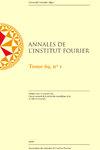加冕仪式和米制空间中的大件
IF 0.7
4区 数学
Q2 MATHEMATICS
引用次数: 10
摘要
我们证明了关于任意d-正则集(不一定是图)的共电离意味着这些(近似)集的大块平方。这在具有整数维的Hausdorff测度的欧几里得空间的(经典)设置中是已知的(并且由于David和Semmes在足够大的共维的情况下,以及Azzam和Schul),其中近似集是Lipschitz图。我们的结果是这些结果的一个很好的推广,我们证明了coronization意味着大块平方是一个一般性质。特别地,当适当地解释时,我们的结果适用于具有固定正(可能是非整数)维度、配备有Borel正则测度和任意近似集的度量空间。作为一个新颖的应用,我们强调了如何在抛物型一致可直性的背景下利用这一通用设置。本文章由计算机程序翻译,如有差异,请以英文原文为准。
Coronizations and big pieces in metric spaces
We prove that coronizations with respect to arbitrary d-regular sets (not necessarily graphs) imply big pieces squared of these (approximating) sets. This is known (and due to David and Semmes in the case of sufficiently large co-dimension, and to Azzam and Schul in general) in the (classical) setting of Euclidean spaces with Hausdorff measure of integer dimension, where the approximating sets are Lipschitz graphs. Our result is a far reaching generalization of these results and we prove that coronizations imply big pieces squared is a generic property. In particular, our result applies, when suitably interpreted, in metric spaces having a fixed positive (perhaps non-integer) dimension, equipped with a Borel regular measure and with arbitrary approximating sets. As a novel application we highlight how to utilize this general setting in the context of parabolic uniform rectifiability.
求助全文
通过发布文献求助,成功后即可免费获取论文全文。
去求助
来源期刊
CiteScore
1.70
自引率
0.00%
发文量
92
审稿时长
1 months
期刊介绍:
The Annales de l’Institut Fourier aim at publishing original papers of a high level in all fields of mathematics, either in English or in French.
The Editorial Board encourages submission of articles containing an original and important result, or presenting a new proof of a central result in a domain of mathematics. Also, the Annales de l’Institut Fourier being a general purpose journal, highly specialized articles can only be accepted if their exposition makes them accessible to a larger audience.

 求助内容:
求助内容: 应助结果提醒方式:
应助结果提醒方式:


